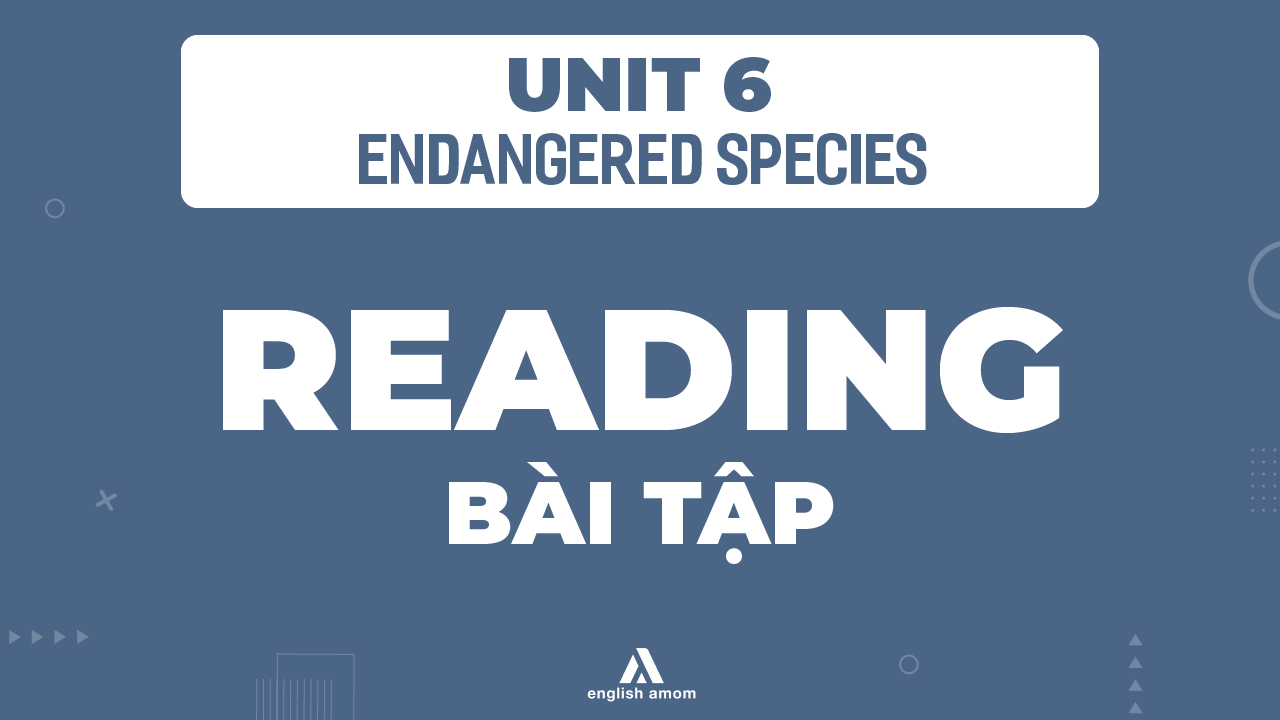
► Kênh hỏi đáp và giải thích thắc mắc kiến thức MIỄN PHÍ → truy cập LINK NHÓM: ENGLISH AMOM
► Kênh YOUTUBE hệ thống toàn bộ bài giảng CLIPS: truy cập LINK: ENGLISH AMOM CHANNEL
► Kênh TIKTOK: ENGLISH AMOM
1) Read the first part of the text about elephants and fill each gap with a word from the box.
| endangered | seeking | abundant |
| wild | dedicated | declining |
The 12th of August is World Elephant Day, which is an international annual event (1) ..................... to the preservation and protection of the world's elephants. Why is there a day for elephants? The answei can be found in the fact that this species' population is rapidly (2) ..................... , and they need help.
In 1930, there were about 10 million African elephants in the wild. In 1989, when they were added to the international list of the most (3) ..................... species, there were about 600,000 remaining. Elephant numbers have dropped by 62% over the last decade, and they could be mostly extinct by the end of the next decade. An estimated one hundred African elephants are killed each day by poachers (4) ..................... ivory, meat, and body parts, leaving only 400,000 alive today.
Asian elephants have never been as (5) ..................... as African ones, and today they are even more endangered. At the turn of the century, there were an estimated 200,000 Asian elephants. Today there are probably no more than 40,000 in the (6) ......................
ĐÁP ÁN:
| 1. dedicated | 2. declining | 3.endangered |
| 4. seeking | 5. abundant | 6. wild |
2) Read the second part of the text and answer the questions.
Elephants are a keystone species, and they play an important role in maintaining biodiversity. Below are some examples.
While looking for food, elephants pull down trees and break up thorny bushes, which helps to create grasslands for other animals to inhabit. In addition, they use their feet to dig up salt licks that are rich in nutrients for themselves and for other animals. Their footprints also create deep holes that water can collect in. Other species rely on this water source in the dry season.
Most importantly, elephant droppings are vital to the environment. Animals such as baboons and birds pick up undigested seeds and nuts from these droppings for their food. This type of waste also works as a kind of manure, which helps humans to have fertile soil to plant their crops. Elephant droppings are also a vehicle for dispersing seeds and making them grow. Some types of seeds will not germinate unless they have passed through an elephant's digestive system. So, if elephants become extinct, those seeds would not grow into trees, leading to an increase in soil erosion and flooding.
What would happen if there were no more elephants on Earth? Elephants maintain the ecosystems in which they live, and make it possible for a lot of other plant and animal species to survive in those environments as well. In a nutshell, if elephants become extinct, many other species will disappear.
1. How can elephants create grasslands for other animals to live in?
................................................................................................................................................
2. Where do many species get water in the dry season?
................................................................................................................................................
3. Where do baboons and birds get their food?
................................................................................................................................................
4. In what way can humans benefit from elephants?
................................................................................................................................................
5. How can elephant droppings affect the growth of some kinds of seeds?
................................................................................................................................................
6. What happens if elephants become extinct?
................................................................................................................................................
7. Where are the two parts of the text above most likely to be found: in a brochure for wildlife protection, or a scientific report about the importance of elephants?
................................................................................................................................................
ĐÁP ÁN:
1 . They create grasslands when they pull down trees and break up thorny bushes while looking for food.
2. They get water that is collected and stored in deep holes created by elephants' footprints.
3. Baboons and birds get their food from undigested seeds and nuts in elephant droppings.
4. Humans can have rich soil which is fertilised by elephant droppings.
5. Some kinds of seeds cannot grow into trees naturally. They can germinate only after passing through an elephant's digestive system.
6. If elephants become extinct, there will be fewer trees, leading to soil erosion and flooding, and many other species will disappear.
7. (Suggested answer) In a brochure for wildlife protection. The rhetorical questions (e.g. Why is there c day for elephants? What would happen if there were no more elephants on Earth?) are used to persuade or influence readers. These questions do not really ask for the answers; they serve to emphasise a point or just get the audience thinking.
3) Find the words or phrases from the two parts of the text which mean the following:
| 1. (of number) calculated approximately, but not exactly | ................................................ |
| 2. existing in large quantities; numerous | ................................................ |
| 3. the most important part (of a plan,idea, etc.) that other parts depend on | ................................................ |
| 4. a place to which animals go to take in salt deposits | ................................................ |
| 5. spreading widely | ................................................ |
| 6. dung; solid waste matter of animals | ................................................ |
| 7. in a few words; briefly | ................................................ |
ĐÁP ÁN:
| 1. estimated | 2. abundant |
| 3. keystone | 4. salt lick |
| 5. dispersing | 6. droppings |
| 7. in a nutshell |

